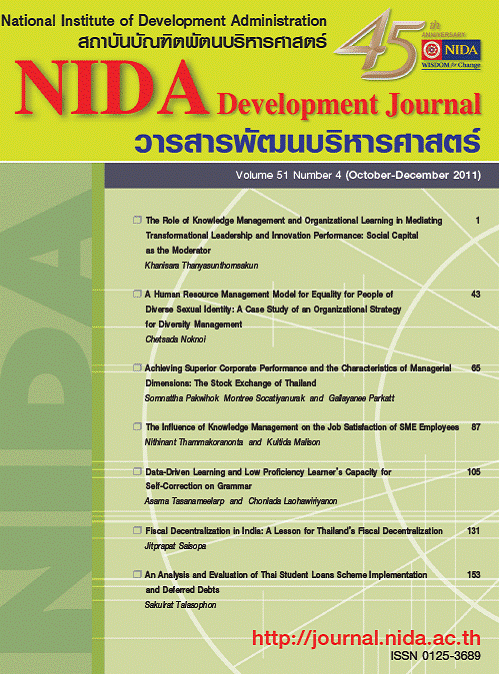Data-Driven Learning and Low-Proficiency Learners’ Capacity for Self-Correction of Grammar ความสามารถในการเรียนรู้ด้วยวิธีข้อมูลขับเคลื่อนเพื่อแก้ไขข้อผิดพลาดทางด้านไวยากรณ์ด้วยตนเองของนักเรียนที่มีความสามารถทางด้านภาษาอังกฤษในระดับต่ำ
Keywords:
Data Driven Learning, Concordances, Low-Proficiency LearnersAbstract
There has been growing use of the application of corpora in language teaching, an example of which is enhancing learners’ capacity to employ concordances to correct grammatical errors in their own writing. This study, conducted from May-October 2009, qualitatively and quantitatively investigated the effect of using concordances on 37 Thai EFL low-proficiency learners’ ability to correct their own grammatical errors in error-correction tasks. The learners were asked to compose a 150 word-long story, prompted by a series of pictures. The five most common errors were then identified; nouns, verbs, prepositions, articles, and subject-verb agreement. As part of the experiment, the researcher used three similar stories to train the learners to notice certain linguistic forms on concordance outputs and to correct the identified errors based on the patterns they induced. Post-test and retention test were used to measure their ability to correctly induce grammatical rules. Stimulated recall interviews were employed to gather information in relation to the strategies they adopted to inductively discover grammatical rules in order to correct the errors. The main findings obtained from the pair sample T-test showed that among the five types of errors, subject-verb agreement was corrected the most accurately whereas prepositions and verbs were the least prevalent errors corrected by learners. The results from the qualitative analyses revealed that different levels of noticing contributed to different types of grammatical pattern induction. The difficulty of self-correction experienced by learners was exacerbated by internal factors (lack of background knowledge and lack of confidence in using the concordances), and external factors (the number of concordance lines that can be consulted, the complexity of the concordance lines, and L1 interference).
ปัจจุบันได้มีการนำคลังข้อมูลภาษามาใช้ในการสอนภาษาอังกฤษเพิ่มมากขึ้น ตัวอย่างเช่น การเพิ่มความสามารถด้านการเรียนโดยการใช้คอนคอร์แดนซ์เพื่อแก้ไขข้อผิดพลาดทางด้านไวยากรณ์ของผู้เรียนด้วยตนเอง งานวิจัยชิ้นนี้เริ่มการทดลองตั้งแต่เดือน พฤษภาคมจนถึงตุลาคม 2552 โดยมีการเก็บข้อมูลทั้งเชิงคุณภาพและเชิงปริมาณเพื่อศึกษาผลกระทบของการใช้คอนคอร์แดนซ์เพื่อแก้ไขข้อผิดพลาดทางด้านไวยากรณ์ของนักเรียนไทยที่มีความสามารถทางด้านภาษาอังกฤษในระดับต่ำจำนวน 37 คน การทดลองเริ่มจากนักเรียนกลุ่มตัวอย่างจะแต่งเรื่องจากภาพจำนวน150 คำ จากนั้นผู้วิจัยได้ทำการตรวจและหาข้อผิดพลาดด้านไวยากรณ์ที่มากที่สุด 5 ตัว ได้แก่ นาม กริยา บุพบท คำนำหน้านาม และประธานและกิริยาที่สอดคล้องกัน ในช่วงระหว่างการทดลองผู้วิจัยได้ทำการสอนให้นักเรียนสังเกตและเรียนรู้ไวยากรณ์จากคอนคอร์แดนซ์ โดยใช้ชิ้นงานสามชิ้นในการฝึกการเรียนรู้กฎไวยากรณ์เพื่อแก้ไขข้อผิด พลาดที่กำหนดให้โดยใช้กฎไวยากรณ์ที่ได้จากการสังเกต หลังจากนั้นผู้เรียนจะต้องทำแบบทดสอบหลังเรียนและแบบทดสอบวัดความทรงจำเพื่อวัดความสามารถทางด้านการเรียนรู้ นอกจากนี้ผู้วิจัยได้ทำการสัมภาษณ์ผู้เรียนเพื่อเก็บข้อมูลในเชิงลึกในเรื่องกลยุทธ์ของการเรียนรู้ไวยากรณ์ของผู้เรียน ผลการทดลองแสดงให้เห็นว่า จากไวยากรณ์ที่ได้ศึกษาทั้งห้าประเภท ความผิดของไวยากรณ์ประเภทการใช้ประธานและกิริยาที่สอดคล้องกันเป็นไวยากรณ์ที่ผู้เรียนแก้ไขได้มากที่สุด ในขณะที่ความผิดของไวยากรณ์ประเภทบุพบทและกริยาเป็นไวยากรณ์ที่แก้ไขได้น้อยที่สุด ข้อมูลในเชิงคุณภาพแสดงให้เห็นถึงความแตกต่างของการเรียนรู้ไวยากรณ์แต่ละประเภท ปัญหาที่พบในการแก้ไขข้อผิดพลาดของผู้เรียนเกิดจากผลกระทบจากปัจจัยภายใน (ขาดความรู้ที่เพียงพอและขาดความมั่นใจในการใช้คอนคอร์แดนซ์) และผลกระทบจากปัจจัยภายนอก (จำนวนคอนคอร์แดนซ์ที่ใช้ในการเรียนรู้ ความซับซ้อนของคอนคอร์แดนซ์และการแทรกแซงของภาษาไทย





